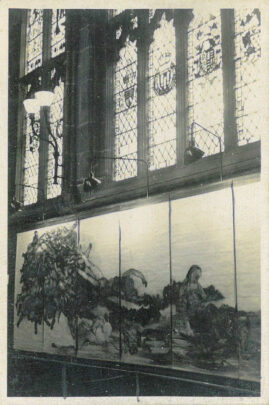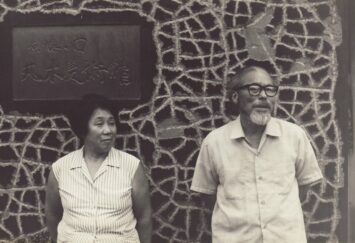
Installation view at St. Mary’s Hall in Coventry in 1955 ©️ Maruki Gallery for the Hiroshima Panels
Private viewTuesday 19 July 2022
6:00pm – 8:00pm
Private View: HIROSHIMA by Iri Maruki and Toshiko Akamatsu
13/14 Cornwall Terrace, Outer Circle (entrance facing Regent's Park), London NW1 4QP
the Daiwa Anglo-Japanese Foundation, Supported by the Maruki Gallery for the Hiroshima Panels, South London Gallery and Southwark Archives 主催
The Hiroshima panels have been brought to this country by Artists for Peace, a grouping of artists with greatly differing political and aesthetic views, but united in their realisation that atomic war would destroy all that Britain is and stands for.
The Paintings are a warning and a protest against the untold suffering caused by one small atom bomb.
But they are not horror pictures; nor are they rhetorical. They were painted by a Japanese man and his wife. Their vision has gone beyond revenge or any dogma.
Calmly, quietly, rationally, but with complete and absolute determination we must follow up their protest until no bombs exist. On that depends, not only our claim to any civilisation at all, but the actual future existence of everything that in the most personal, individual, intimate way each of us may love.
John Berger, 1955
Iri Maruki and Toshko Akamatsui (also known as Toshi Maruki) witnessed the aftermath of the atomic bomb, which resulted in the death of over 140,000 people – and the subsequent physical, mental and social effects on the general public. Five years later still under the Press Code, Iri and Toshiko exhibited their first large-scale panel in the Genbaku no Zu series, also known as the Hiroshima Panels which subsequently stretched over 32 years and yielded 15 works. The last piece in the series was entitled Nagasaki.
As the pair developed these panels, more people shared their stories, adding to the moments of despair and the other memories depicted. In order to create these expansive works, the artists drew more than 900 human figures, reflecting how their lives were forced to stop. The works became an apparatus to convey the story of the atomic bombing of Hiroshima and Nagasaki to the general public, first during a period of censorship, then during protests against nuclear weapons by the artists and their supporters. Amidst a mood of fear and anger towards the Cold War, almost 20 countries invited the works to be exhibited in a gesture of peace and transnational solidarity.
As we potentially enter an era of escalating nuclear rhetoric, the Daiwa Anglo-Japanese Foundation showcases the panels’ drawings, a film and exhibition archives of the English tour in 1955 as an opportunity to reflect on the consequences of nuclear warfare.
コントリビューターについて

Iri Maruki and Toshiko Akamatsu
Iri Maruki (1901 – 1995) was born in a small village in Hiroshima. He was part of avant-garde artist groups such as the Rekitei Art Association and the Bijutsu Bunka Association. His unique style of suibokuga (ink wash painting), influenced by pre-War surrealist and abstract art, established his reputation. When the duo arrived in Hiroshima just days after the atomic bombing, they assisted surviving members of Iri’s family and were first-hand witnesses to the aftermath of the nuclear attack.
Toshiko Akamatsu (also known as Toshi Maruki) (1912 – 2000) was born in Hokkaido, where her father was the head priest of Zenshōji Temple. She studied oil painting at the Women’s Academy of Fine Arts (now Joshibi University of Art and Design), and later spent time in both Russia and Micronesia as a private tutor in order to see actual artworks beyond catalogues, which were difficult to access in pre-War Japan. Studying at university, moving away from home to study, focussing on oil painting instead of Japanese painting, and traveling overseas were extremely rare, but even more so for a woman. She was the motivational force in continuing the panels to get across their message when Iri retreated from the work under the pressure of criticism. Toshiko later garnered attention as an author of the children’s books Hiroshima no Pika and Tsutsuji no Musume. She was actively participating in women’s international congresses.
Their collective practice can be described in today’s terms as socially engaged art, due to their committed fieldwork and continuous engagement with people affected by past events. It was for these monumental works, along with their steadfast efforts to work for peace in Japan and beyond, that the couple were awarded the International Peace Prize by the World Peace Council in 1953, nominated for the Nobel Peace Prize in 1995. A documentary film, Hellfire: A Journey from Hiroshima by John Junkerman which featured Iri and Toshiko on the Hiroshima Panels was also nominated for the Academy Award for Best Documentary Feature in 1986.
Images © Maruki Gallery for the Hiroshima Panels